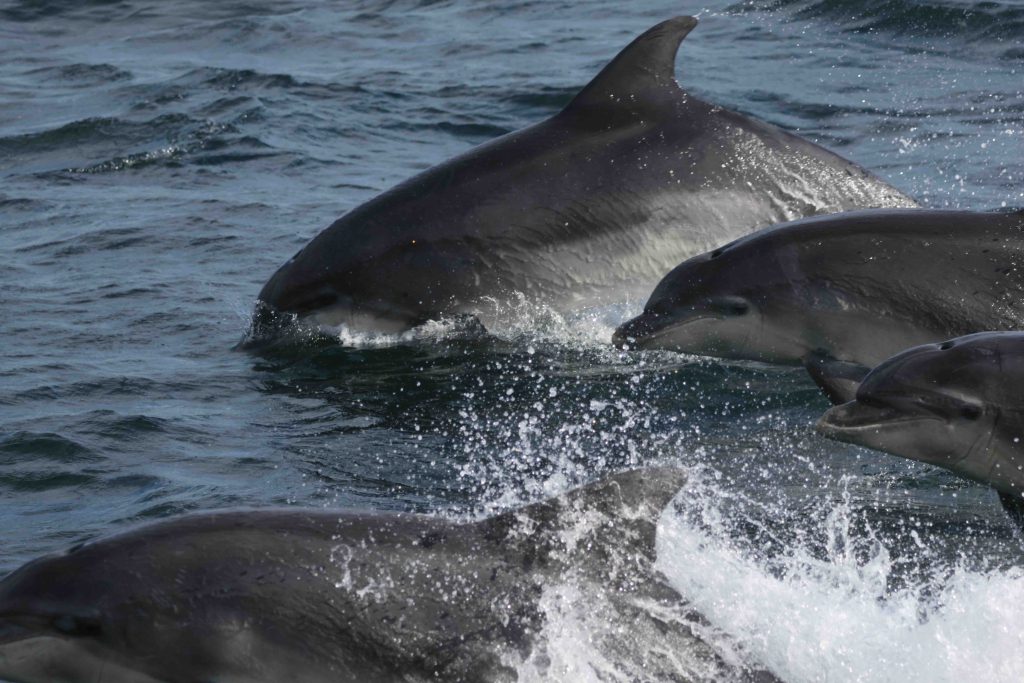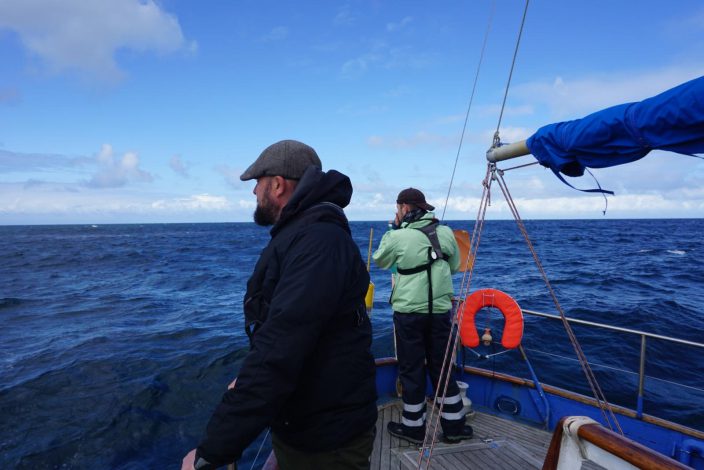
Effort watching
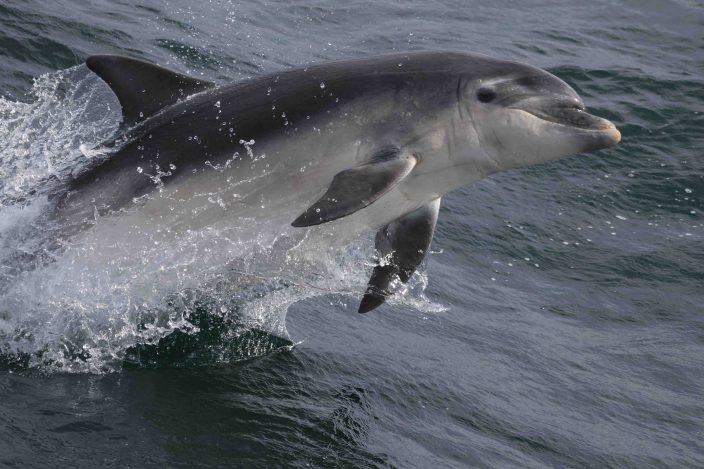
Monday
The next morning, we made for Kilkee with a bumpy sea which sent a few of our crew members to the stern to feed the fish with our breakfast; we quickly learned to vomit downwind. We all continued surveying despite the sea sickness. We had a group of bottlenose dolphins including Beast, and Titan as well some calves with mothers so our photographers, Dominique, Jo, and Harvey were shooting photos as fast as possible for later identification. Harvey hung from the bow like an acrobat to get bow shots which impressed me, as I couldn’t even tie my laces without feeling ill in such a swell. After Loop Head we were treated to a closeup of a storm petrol who came within 30 feet of the boat and gave us a good view of his white rump. We also got a glimpse of a Corys’ Shearwater, a bird similarly shaped to the Manx shearwater, but with longer wings and beautiful brown-grey colouration above and white below; a vagrant who can appear on the West coast from July to September.
We collected our Marine Biologist, Mags, from Carrigaholt pier on Monday evening ready for a trip to Brandon Bay on Tuesday morning. The sea was calm and we got good shots of the Shannon dolphins as we left the bay, followed by 2 glimpses of common dolphins and a great skua at Loop Head. Before we hit Brandon-Bay we got a quick glimpse of a small sunfish as it waved at us with its dorsal briefly from the port side before disappearing under the surface. As we approached the coastal fields west of Brandon, we were met by a group of 3 bottlenose including Kite who hung around the bow while other groups of dolphins remained at a distance. Kite seems the most content bow-riding, and has a number of marks and rakes on his/her (yet to be genital shotted) back and fin. Kite remained at the bow for a long time content to swirl with the bow alone and show off while the photographers had to estimate the location of the remaining pod members who were more difficult to photograph. The first dolphin I viewed bow-riding seemed to have an asymmetrical underbite (almost crossbill appearance) visible from above the water. Mags advised us this is Buba who has a protrusion of some kind coming from what appeared to be the lower rostrum. This white growth made Buba distinctive, but for me, it was only visible at close range from above. During the rest of the views of the Brandon pod I was unable to distinguish Buba from the others. After mooring in Brandon, the dolphins reappeared before dark, bow riding on a trawler as he pulled into the harbour.

Common Dolphin Ariel shot
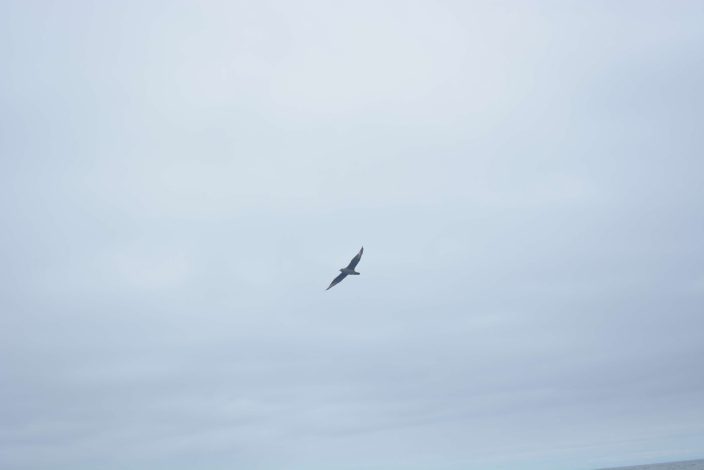
Great Skua
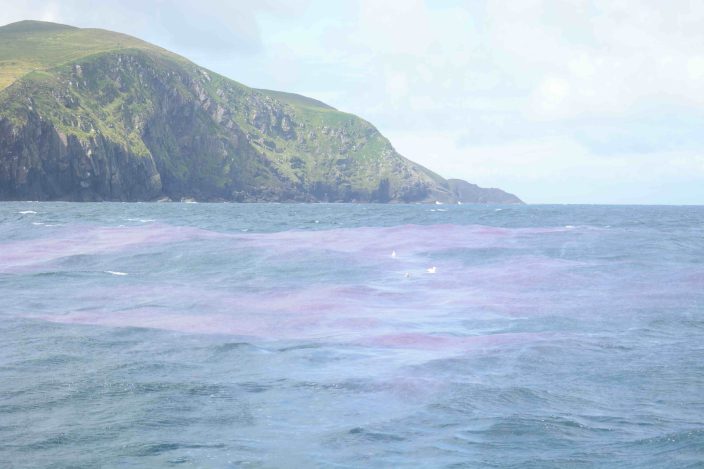
Moon Jelly cloud in front of cliffs
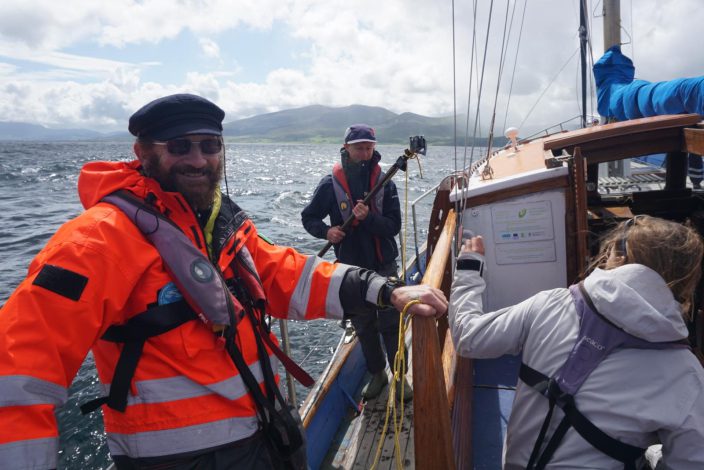
GoPro launch for moon jelly soup
We swung back into action with 4 SLR cameras positioned around the hull to get as many fin shots as possible. The dolphins were in better form on Wednesday and treated us to quite a few ariel flips rewarding us with multiple genital shots. With so many jellies and genitals our crew was very happy to return to Fenit Marina after a good day of survey work. We were met by the “fenit three”, Samphire, Doyle and her juvenile calf. The wind was howling, and we were pulled away from the dolphin trio as we prepped for an intense mooring in choppy waters. I found out that I quite enjoyed scrambling about the boat with a roving fender aiming it at any piece of hull which may make contact with a piece of marina.
Thursday was spent hanging out over the Marina pontoons learning from Harvey about the reef colonies of large sea-squirts, lightbulb sea squirts, sponges, and even some miniscule sea slugs. We also had about 10 huge mullet, Shrimp, giant plumous anemone and a family of large spider crabs living off the Marina pontoons close to our position. Irene baked fresh bread for the crew to keep us in high spirits, and almost all the crew got into the water for a beach swim before dinner. I am sure I speak for all the crew when I say that having first mate Irene on your boat makes for a really enjoyable occasion, and would like to thank her for all the fresh bread, and culinary support provided to all us “wannabe” chefs. I also have to mention captain Liam who together with Irene gave us so much of their knowledge and experience in such a kind manner. I am truly grateful as a newbie sailor to not get shouted at while surveying, but instead have a really enjoyable time learning and supporting the professionals on our crew.

Reef Biology under Fenit Marina pontoons

Spider Crab
On Friday we encountered the Brandon Bay pod once again with Harvey shooting lots of genital shots and the rest of us cursing our angles. We also got another closeup of the giant cloud of Moon Jellies and got a go-pro into the water attached to a boat hook to get some closeup footage. Seems to have been some mauve stingers in the mix also but far outweighed by the moon jellies. There was no sign of the Fenit 3 on the final day, but we saw a great skua as we came home to Fenit to end the week. We floated the rib lifeboat into the water for our final mooring at Fenit. Harvey and Sean went ashore in the rib and radioed back to the main vessel, while Dom and Jo handled the lines. I thought my roving fender would burst as it got pinched between the dock and the sharpest point on the locked anchor at the bow. I was quite impressed to see the fender take to full strain of the ship head-on to on a sharp metal anchor point without bursting. All in all, we had a successful mooring to end the Shannon Dolphin Survey week 3. My very best wishes to the remaining crew who continue to survey in the coming weeks. I know you will see dolphins, but I am wishing you Minkes and Humpbacks so I can live vicariously through your photo adventures.
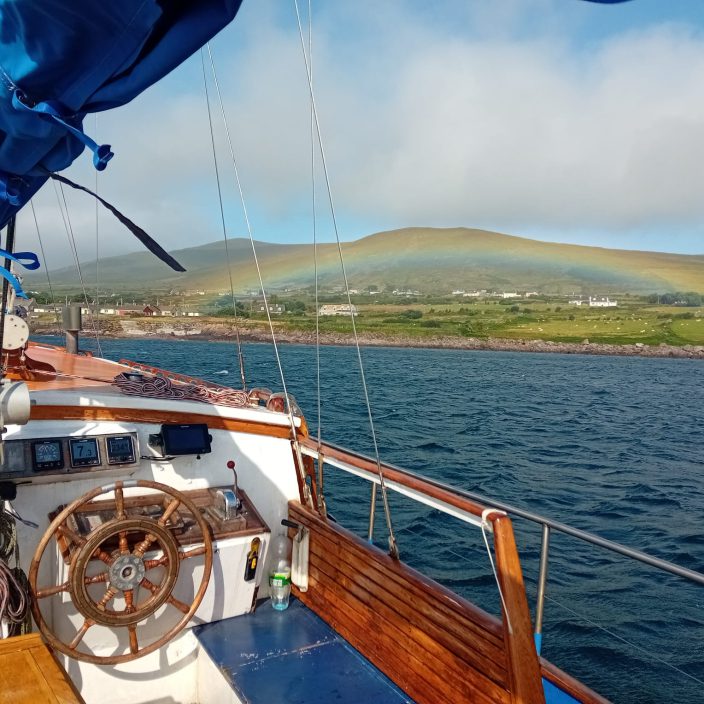
Brandon Bay rainbow
Thanks to the whole crew; to Mags for the joys of watching her identify individual animals from laptop images (something which I found immensely satisfying) and sharing her knowledge and big thank you to Jo, Harvey and Dom who were such a fun and pleasant marine science crew, teaching and supporting us in our first ocean leg. Jo also beat me in the Fenit 5k, and Harvey beat me in a beach swim, but I am consoled by the fact that I beat Harvey in the 5k, even if he was hungover. I will take all the wins on this adventure that I can get! Thanks also to my bunkmate Sean, who gave us plenty of evening chats, games and entertainment. Great to see so many people doing so much to help our oceans and our knowledge of the remaining species in this crucial habitat.
by Mark O’Mahony
IWDG Member

